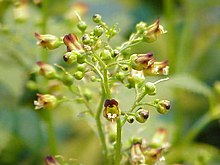Scrophularia: Difference between revisions
→Selected species: add 2 x spp. |
Yogabear2020 (talk | contribs) m ce deleted "for" in redirect "other plants" b/c "For" auto filled WP:FIX 'for for' |
||
| (6 intermediate revisions by 2 users not shown) | |||
| Line 1: | Line 1: | ||
{{Short description|Genus of flowering plants}}{{More citations needed|date=July 2012}} |
{{Short description|Genus of flowering plants}}{{More citations needed|date=July 2012}} |
||
{{Redirect|Figwort| |
{{Redirect|Figwort|other plants sometimes referred to as figwort|List of plants known as figwort}} |
||
{{Automatic taxobox |
{{Automatic taxobox |
||
|image = Scrophularia nodosa8.jpg |
|image = Scrophularia nodosa8.jpg |
||
| Line 7: | Line 7: | ||
|authority = [[Carl Linnaeus|L.]] |
|authority = [[Carl Linnaeus|L.]] |
||
|subdivision_ranks = Species |
|subdivision_ranks = Species |
||
|subdivision = |
|subdivision = 289, see [[List of Scrophularia species|List]] |
||
| synonyms = {{hidden begin|title = List}} |
|||
* ''Ceramanthe'' <small>(Rchb.) Dumort.</small> |
|||
* ''Mosheovia'' <small>Eig</small> |
|||
* ''Oreosolen'' <small>Hook.f.</small> |
|||
* ''Scrophucephalus'' <small>A.P.Khokhr.</small> |
|||
* ''Tomiephyllum'' <small>Fourr.</small> |
|||
* ''Tuerckheimocharis'' <small>Urb.</small> |
|||
* ''Venilia'' <small>Fourr.</small> |
|||
{{hidden end}} |
|||
}} |
}} |
||
| Line 14: | Line 23: | ||
''Scrophularia'' species are used as food plants by the [[larva]]e of some [[Lepidoptera]] species including ''[[Phymatopus|Phymatopus hectoides]]''.{{citation needed|date=July 2012}} |
''Scrophularia'' species are used as food plants by the [[larva]]e of some [[Lepidoptera]] species including ''[[Phymatopus|Phymatopus hectoides]]''.{{citation needed|date=July 2012}} |
||
Some species in this genus are known to contain potentially useful substances, such as [[iridoid]]s, and several ''Scrophularia'' species, such as the [[Ningpo figwort]] (''S. ningpoensis''), have been used by [[herbal medicine]] practitioners around the world. The name ''Scrophularia'' comes from [[scrofula]], a form of [[tuberculosis]], because several species have been used in herbal medicine for this disease.<ref name=culpeper>Culpeper |
Some species in this genus are known to contain potentially useful substances, such as [[iridoid]]s, and several ''Scrophularia'' species, such as the [[Ningpo figwort]] (''S. ningpoensis''), have been used by [[herbal medicine]] practitioners around the world. The name ''Scrophularia'' comes from [[scrofula]], a form of [[tuberculosis]], because several species have been used in herbal medicine for this disease.<ref name="culpeper">{{Cite book |last=Culpeper |first=Nicholas |title=Culpeper's complete herbal: a book of natural remedies for ancient ills |publisher=Wordsworth Editions |year=1998 |isbn=978-1-85326-345-3 |series=Wordsworth reference series |location=Ware}}</ref><ref name="Garran">{{Cite book |last=Garran |first=Thomas Avery |title=Western Herbs according to Traditional Chinese Medicine: A Practitioner's Guide |date=2008-01-22 |publisher=Healing Arts Press |isbn=9781594771910 |language=English}}</ref> |
||
==Selected species== |
==Selected species== |
||
Latest revision as of 20:36, 28 February 2024
This article needs additional citations for verification. (July 2012) |
| Scrophularia | |
|---|---|

| |
| Scrophularia nodosa | |
| Scientific classification | |
| Kingdom: | Plantae |
| Clade: | Tracheophytes |
| Clade: | Angiosperms |
| Clade: | Eudicots |
| Clade: | Asterids |
| Order: | Lamiales |
| Family: | Scrophulariaceae |
| Tribe: | Scrophularieae |
| Genus: | Scrophularia L. |
| Species | |
|
289, see List | |
| Synonyms | |
|
List
| |
The genus Scrophularia of the family Scrophulariaceae comprises about 200 species of herbaceous flowering plants commonly known as figworts. Species of Scrophularia all share square stems, opposite leaves and open two-lipped flowers forming clusters at the end of their stems. The genus is found throughout the Northern Hemisphere.
Scrophularia species are used as food plants by the larvae of some Lepidoptera species including Phymatopus hectoides.[citation needed]
Some species in this genus are known to contain potentially useful substances, such as iridoids, and several Scrophularia species, such as the Ningpo figwort (S. ningpoensis), have been used by herbal medicine practitioners around the world. The name Scrophularia comes from scrofula, a form of tuberculosis, because several species have been used in herbal medicine for this disease.[1][2]
Selected species[edit]


|
References[edit]
- ^ Culpeper, Nicholas (1998). Culpeper's complete herbal: a book of natural remedies for ancient ills. Wordsworth reference series. Ware: Wordsworth Editions. ISBN 978-1-85326-345-3.
- ^ Garran, Thomas Avery (2008-01-22). Western Herbs according to Traditional Chinese Medicine: A Practitioner's Guide. Healing Arts Press. ISBN 9781594771910.
